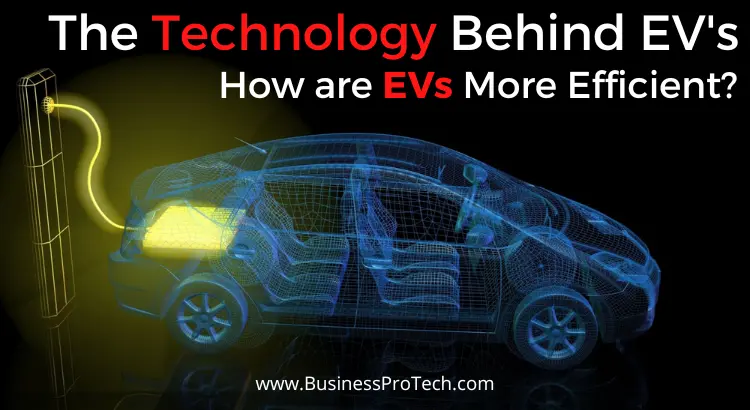With the UK government pledging to eliminate petrol and diesel cars from the roads by the year 2030, there’s never been a better time to get in on the electric vehicle (EV) trend.
Whether you’re interested in switching to an EV to do your bit for the environment, reduce running costs or stay ahead of the push for a zero-emission UK, there’s no denying that the technology used to manufacture and power EVs is markedly more efficient than that used in conventional fuel engines – but why are EVs so much more efficient than petrol and diesel cars?

The Difference Between EVs and Non-EVs
In order to figure out why EVs are so much more efficient than their fuel-burning counterparts, it’s important to first distinguish the major differences between the two.
Whereas a traditional petrol or diesel-powered vehicle relies on the combustion of fuel (with the heat energy produced by burning fuel converted into motion), EVs convert electricity alone to power the motion of a car using a motor.
Whereas the use of petrol and diesel engines may be considerably more expensive in the long run (not to mention more harmful for the environment in terms of emissions), it’s also considerably less efficient – because most diesel-powered vehicles only usually reach a peak of 40% efficiency, most traditional cars actually waste more than half of their energy combusting and converting fuel.
Comparatively, many EVs reach an average efficiency of up to 70%, making them much less wasteful to run. You’re also likely to face lower running costs and lower rates of road tax if you opt for an EV or hybrid vehicle, despite the relatively high initial cost of purchase.
The Growing Popularity of Electric Vehicles
While the initial cost of purchasing an EV remains relatively high, it’s now easier than ever to lease an electric vehicle or access one through a government loan or community transport initiative, where you’ll share ownership with others.
This growing accessibility has led to a surge of interest from drivers worldwide since 2010, with sales of electric cars rising by 186% in 2020 alone; the following year, more than 11% of all new cars sold were classed as battery electric vehicles (BEVs) and around 7% were classed as plug-in hybrid electric vehicles (PHEVs); as of late 2022, new EVs have a whopping share of over 15% of the UK’s new car market.
Indeed, it’s not just brand-new EVs that have perked the interest of prospective car buyers in the UK and worldwide – demand for used and second-hand EVs surged by 119.2% in 2021. With growing numbers of EV and hybrid drivers, we’ve also seen a developing EV infrastructure in the UK, which includes 28,375 public charging points as of January 2022, indicating a growth of 37% from the previous year.
While there’s been some controversy regarding the geography of the EV charging point rollouts (with certain areas being underserved when compared to others), there’s no doubt that this infrastructure will improve as we move ever closer to the government’s 2030 target.
Regenerative Braking System
Another major factor that makes EVs and hybrid cars much more efficient than fuel-powered engines is the fact that they make use of modern tech such as regenerative braking systems.
These work by recovering energy that’s depleted when the EV brakes, this is a mechanism that slows down a moving car, allowing the car to then accelerate quickly after braking with minimal wasted energy.
This is done by converting the garnered kinetic energy through an electric motor working as an electric generator, into energy that can help propel the vehicle without using the existing charge inside the battery packs of the vehicle.
Because conventional car brakes do little more than convert heat energy, which is then wasted, EVs may be up to three times more energy-efficient than petrol or diesel-powered vehicles when it comes to putting on the brakes.
Having said this, the technology is limited to how quickly the driver wants to come to a stop. If a driver is moving at high speed, for example, and wants to come to a stop in a relatively short time and distance, the conventional braking system will be needed in order to further slow down the vehicle to make the abrupt stop.
If you’re wondering why this wonderful bit of engineering isn’t used on fuel-powered vehicles, it’s because this technology would be difficult and arguably uneconomical to implement on non EV’s; which do not have an electric motor to capture the kinetic energy.
In the long run, implementing this technology on all vehicles will definitely help reduce our collective energy consumption, in a small but efficient way, as well as reduce spare parts for brake discs and pads. Further reducing energy consumption and carbon emissions.
What About the Environmental Impact?
Despite what some may say, it is widely known that EVs, especially battery-powered models, are far greener than combustion engine-powered vehicles.
This is especially true in countries such as Norway which generates most of its electricity from hydropower plants, which means that a Tesla Model 3 for example, would only need to travel a few thousand miles (8,400 according to studies) to reach parity with a fuel-guzzling vehicle.
This goes without saying that you would also benefit from cleaner air, which is a luxury in some parts of the world, and reduce the number of deaths related to breathing polluted air. This is a significant factor that often gets overlooked or left unaccounted for when weighing up the real environmental impact of EVs.